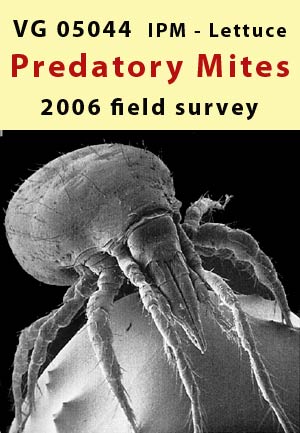|
|
As part of a search for biological control agents of lettuce pests and reduced reliance on pesticides, a survey of arthropods in soils collected from lettuce fields was conducted in SA, VIC and NSW. Populations of the sampled soil arthropods, such as collembolans (springtails), tyrophagous and oribatid mites (all detrivores and fungivores) and predatory mites, were generally low in most of the soil samples received from lettuce fields in 2005-06. We speculate that the low populations of arthropods in these field samples is likely due to the combined pressures of regular disturbance, multiple pesticide applications and low soil organic carbon levels.
Summary : The arthropod populations sampled across five vegetable growing regions appear more specific to individual growers than particular regions. Most of these predators are mesostigmatid mites, including Hypoaspis spp., Machrochelidae, Pachylaelaps sp. (P. australicus?), Pergamasus sp., Protogamasellus mica, Dendrolealaps sp., Athasiella relata and several unidentified Parasitidae species. All of these soil-inhabiting predatory mites may be able to contribute to the control of western flower thrips pupae in soils of lettuce fields. Hypoaspis sp. is a large (2mm) aggressive hunter predator that has been shown to feed on a range of small arthropods, and is available commercially as a biological control agent. Pergamasus sp. (Acarina: Parasitidae) and an unidentified Parasitid mite, both of a similar size to Hypoaspis, have been found in soil samples and within lettuce heads at Murray Bridge and Werribee. These mites are fast-moving hunters that are known to feed on a wide range of small arthropods, and potentially could feed on early instar thrips and aphids. It is likely that these beneficial mites are able to persist in the soil between crops feeding on small arthropods such as other soil mites and springtails. There are a numerous studies that report negative effects on soil-dwelling predatory mite populations and the use of synthetic insecticides such as organophosphates and synthetic pyrethroids. Populations of these beneficial mites are highest where there is the combination of high organic carbon content in the soil and no pesticide application, and lowest where there is a combination of low organic carbon and high pesticide use. In summary, a range of soil-dwelling predatory mite species are present in most lettuce fields sampled across VIC, NSW and SA in this 2005-06 study. Although the densities of these predators are generally low, some changes to current soil management practices and pesticide programming may create conditions suitable for these predators to flourish, and thereby help control difficult pests such as western flower thrips. In particular, the soil and foliage hunter Pergamasus sp., with potential as both a thrips and aphid predator, and possibly possessing some pesticide tolerance, warrants further attention. Acknowledgments : This report is part of project VG05044 and was supported by the National Vegetable Levy and AusVeg. Dr Sandra McDougall of the NSW Department of Primary Industries obtained project funding, provided liaison with Horticulture Australia Limited and AusVeg. |
||||
|

